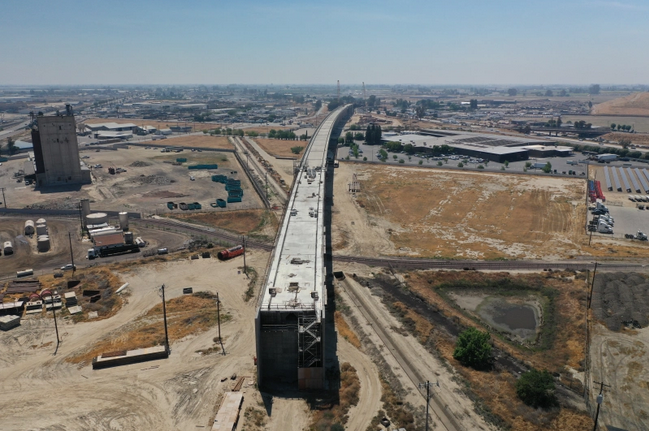Here are a few Streetsblog news nuggets.
More positive realities on the state's rail modernization project and how far its come.
Streetsblog has tried to push back against the onslaught of anti-rail propaganda aimed at California's ongoing rail modernization project. The California High-Speed Rail Authority is also attempting to set the record straight, reiterating how much as been accomplished. From a release:
California high-speed rail has 119 miles under construction with 35 active sites in the Central Valley. Nearly 300 miles of the 500-mile Phase 1 System between the San Francisco and Los Angeles/Anaheim have been fully environmentally cleared. To date, more than 7,000 construction jobs have been created since the start of construction.
However, nothing speaks louder than seeing the construction for one's self, as Streetsblog's editors have done. But if you don't have time to get to the Central Valley right now, the California High-Speed Rail Authority has put together a video, reviewing all the construction advancement that's taken place this year.
It includes interviews and drone footage of all the major construction work. If you want an update of what's happening, be sure to check it out.
Bike safety, gondolas, and more smoke and mirrors with the Oakland A's ballpark proposal
The Final Environmental Impact Report for the Oakland A's proposed new ballpark at the Howard Terminal site in Jack London Square dropped today and bike-safety advocates are not happy with what they're reading.
As Bike East Bay's Robert Prinz put it:
The Howard Terminal final EIR continues to gut the 3rd Street protected bikeway from Oakland’s 2019 bike plan, and maintain only the dangerous, minimum width unprotected bike lane on 2nd Street which already exists, and is almost unusable due to blockages. https://t.co/FnvibqgXo2 pic.twitter.com/S1ws2NqUWx
— Robert Prinz (@prinzrob) December 17, 2021
So why is the image with this story of a gondola and not a bike lane?
When the owners of the A's first announced their idea for a new ballpark back in 2019, their releases featured images and video renderings of an exciting gondola to connect the stadium with downtown Oakland and BART. That was to show how "green" they are and how much they want to have transit access. But as Streetsblog pointed out at the time, there's no reason to build a gondola over level, dry, perfectly walkable and bikeable land. If they were serious, they might have discussed a gondola from the new stadium across the estuary to Western Alameda, a project that has been talked about before and would actually serve a purpose for baseball fans and the general public alike.
In other words, when it comes to transportation, it was clear from jump that the A's are not serious (how else could they justify leaving a location with a dedicated BART and Amtrak station?). So it's not a huge surprise that the EIR is now punting bike and pedestrian safety features that the project was supposed to fund in exchange for city and taxpayer support. "The EIR in a few locations says what is planned for bike improvements doesn't preclude safe, comfortable bikeways," said Dave Campbell of Bike East Bay. However, savvy advocates recognize when they're getting smoke blown up their collective asses. "I can get that from Caltrans."
Bike East Bay is working on a detailed response to the 200-plus-page EIR. Streetsblog will continue to follow this developing story.
S.F. County Transportation Authority announces $5.8 million for Vision Zero quick-builds.
San Francisco's Transportation Authority (TA) approved nearly six million dollars this week to support SFMTA’s Vision Zero Quick-Build Program. That will projects to improve pedestrian and bicycle safety on the Vision Zero High Injury Network. From a TA release:
This program installs quick-to-deliver reversible and adjustable traffic measures to improve pedestrian and bicycle safety on the Vision Zero High Injury Network. These quick-build measures may include painted safety zones, protected bike lanes, transit boarding islands, parking and loading changes, and more. The $5.8 million in total funding will support 10 quick-build corridor projects identified at high-need locations. Programmatic spot improvements throughout the city and outreach and evaluation efforts will also be supported by this funding. All corridor projects will be completed on a rolling basis and all are anticipated to be open for use by December 2023:
The following locations that will get the quick builds are:
- Lake Merced Boulevard (Skyline to John Muir)
- Hyde Street (Market to Geary)
- 17th Street (Potrero to Pennsylvania)
- Oak Street (Shrader to Baker)
- 3rd Street (Bay Trail to Townsend) & Townsend Street (3rd to Embarcadero)
- Alemany Boulevard (Congdon to Ellsworth)
- Lincoln Way (22nd to Arguello)
- Sutter Street (Market to Polk)
- Frida Kahlo/Ocean/Geneva
- Franklin Street (Broadway to Lombard)
Streetsblog can only say that if these treatments are being built with concrete and/or steel in a way that will force motorists to slow down and drive safely, great. Concrete and planters are cheap and there's nothing stopping the city from using materials that can physically stop a motorist from driving dangerously. If it's just more paint and silly straws, which is what it sounds like, then the city still isn't serious about Vision Zero.






